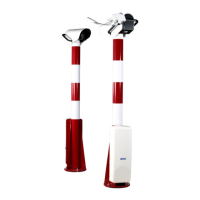Chapter 4 _______________________________________________________________ Installation
VAISALA ______________________________________________________________________ 123
Finalizing On-site Receiver Assembly
Orientation of Support Unit
1. Place the ladder behind the receiver mast and check the orientation
of the support unit.
2. Loosen the two fastening screws (hex socket, size 4) on the right
side (operator's view) of the mast top. The complete support unit
must now be turnable. See Figure 52 on page 97.
3. Align the support unit horizontally onto the transmitter mast. Use
the sight hole in the rear plate together with the sight pin. See
Figure 53 on page 98.
4. Fix the two fastening screws of the support unit at the mast top.
The support unit will not be moved again.
5. The sight must show now the measurement head of the transmitter.
Otherwise the support unit position and/or the vertical alignment of
the mast have to be checked. Probably a slight tilting of the mast is
necessary due to foundation level differences.
6. If the sight shows the measurement head of the transmitter, the
foundation nuts can be fixed as tight as possible to allow for a safe
positioning of the mast. A torque of 60 ... 80 Nm is recommended.
Foundation Level Differences
Tilting the Receiver Mast
If the level of the receiver foundation is significantly different, that is,
more than ± 20 cm, from that of the transmitter foundation, the sight will
image an area below or above the transmitter measurement head. In that
case, the receiver mast has to be slightly tilted off the perpendicular
alignment.
1. Move the mast by turning the nuts above and below the base plate
on the front foundation screw. See Figure 66 on page 111.
NOTE
The two other securing nuts have to be loose enough to allow the slight
movement of the base plate.
2. After this alignment is finished, the foundation nuts must be fixed
as tight as possible to allow for a safe positioning of the mast. A
torque of 60 … 80 Nm is recommended.

